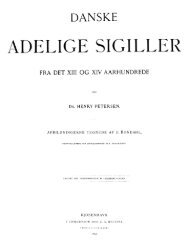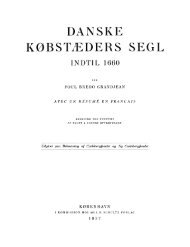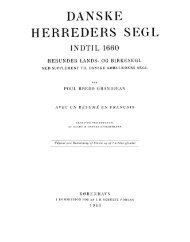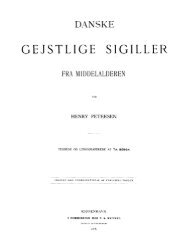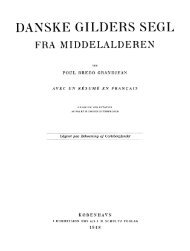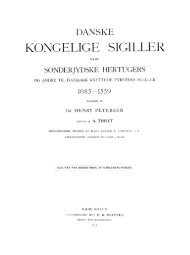Oldtidsagre - Genstandskundskab
Oldtidsagre - Genstandskundskab
Oldtidsagre - Genstandskundskab
You also want an ePaper? Increase the reach of your titles
YUMPU automatically turns print PDFs into web optimized ePapers that Google loves.
152 Nr. 1<br />
with an arð, and the loose stones of handsize were hardly any obstacle to this implement.<br />
Neither did the stones represent any hindrance to the reaping with sickle.<br />
They might, however, be in the way of a scythe. And, in STEENSBERG,S opinion, a<br />
short scythe was used in the Early Iron Age, not for the corn, but for other plants,<br />
e. g. polygonum, which probably filled the fields in many places during the years<br />
when they were lying fallow (not used for corn) (STEENSBERG 1943, p. 249).<br />
Also in later times, field-stones were collected and placed upon the balks. In<br />
stony regions, fields are often separated by rows of stones, which does not, of course,<br />
prove that the fields are prehistoric. In a previous work, I have referred certain<br />
parallel stone-rows in Fogstrup heath to the Pre-Roman Iron Age, because some<br />
adjacent stone-heaps contained pot-sherds from that period (HATT 1931, p.121).<br />
A later investigation (cf. above, p. 113) has proven that the stone-heaps with potsherds<br />
belong to a system of typical >><strong>Oldtidsagre</strong>« in Fogstrup, while the parallel<br />
stone-rows are younger than the “()ldtidsagre".<br />
In one instance, No. 113, Ølgaard, the balks consisted of heath-turf in several<br />
layers. This instance is, however, not typical and could not be dated.<br />
In the locality No. 91, Harild, there were remnants of heath-turf in the innermost<br />
part of some of the balks. This instance is, however, not typical and somewhat<br />
doubtful-the balks or ridges being mainly a result of sand-drifting.<br />
In several cases, a small temporary hearth was found beneath the edge of a<br />
balk (see e. g. Fig. 2, from No. 25, Gundersted). This might give rise to the idea,<br />
that the balk was originally an earthen wall which had subsided, sliding down over<br />
the fire-place. However, this is probably not the true explanation. It is more likely<br />
that the balk has grown in height and breadth and in that way has covered the<br />
fire-place.<br />
The ridge-shaped balks of the “<strong>Oldtidsagre</strong>“ were probably never very much<br />
higher than they are now. This is corroborated by the find of ancient fields beneath<br />
the Nørre Fjande village-site (HATT 1941, p. 159 seq.), where the balks have preserved<br />
their original form, covered by drifting sand two millenniums ago.<br />
V. Dating of the ancient fields.<br />
In some localities where ancient fields occur together with burial-mounds from<br />
the Later Stone Age and the Early Bronze Age, it seems evident that the burialmounds<br />
must have been in existence at the time when the fields were laid out, as<br />
the direction of the balks seem to be determined by the position of the mounds<br />
(c.f. No. 19, Fald, p. 35, No. 20, Vindblæs, p. 36, No. 27, Skørbæk, p. 41, No. 60, Fly.<br />
p. 77). However, the Stone Age and Bronze Age mounds do not tell us anything more<br />
definite about the age of the ancient fields. It should also be observed that most of<br />
the burial mounds in the Jutland heaths are without any connection with ancient



